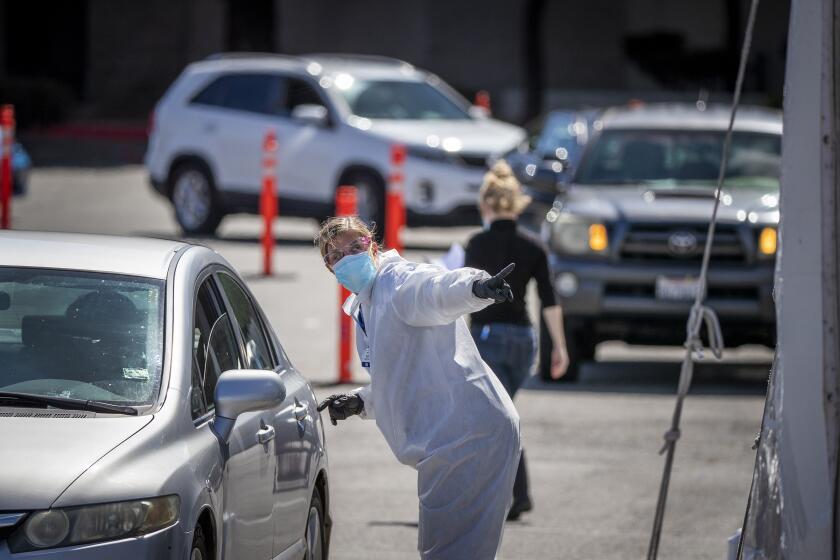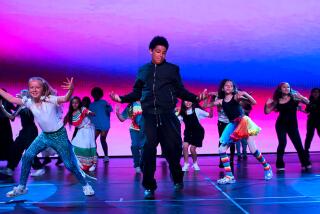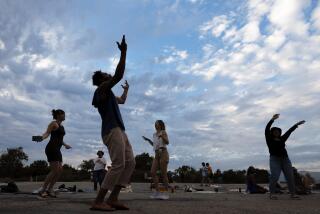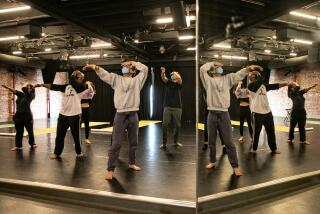Op-Ed: Got cabin fever? It’s time to dance
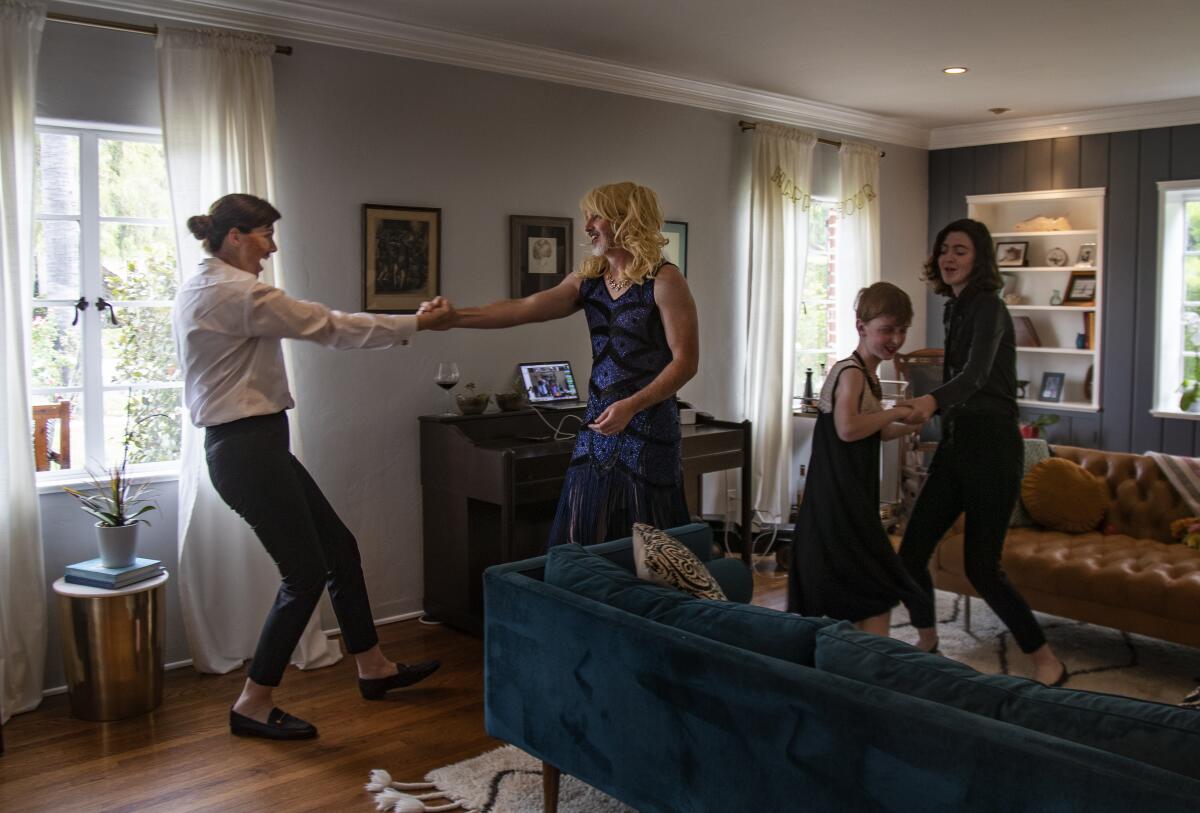
- Share via
Eight years ago, when my boyfriend and I started dancing in our living room after dinner, little did we think our somewhat eccentric pastime would sweep the nation. But if social media are any gauge , dancing at home is the coronavirus pandemic’s bathtub gin.
Confined to the all-too-familiar patch of steel and plaster we call home, Americans are sashaying and kick-ball changing our sadness and fear away. Families are erupting into tiny pageants of jazz hands. A dance challenge started by the video-sharing app TikTok, meant to promote social distancing, has drawn more than 4.6 billion views. Videos from LeBron James, Mark Wahlberg and Judd Apatow suggest that now may be the best time ever to see heterosexual men tangle with precision choreography.
But beneath the roar of approval and delight elicited by all this shimmying and twirling, you can hear a whine of disapproval. When Courtney Cox, the “Friends” star, put up a sultry video of herself dancing to “Slidegang!” by Lil Jackie, the backlash was immediate: “You know thousands of people just lost their jobs right?” Or, as one viewer of a wildly popular video featuring a father in Louisville, Ky., dancing with his two adult sons sniffed, “Really?????”
Crises, as any satirist or corporate publicist will tell you, wreak havoc with tone. One man’s Fosse-esque shoulder isolation is another man’s blackface. It doesn’t help that dance, by showcasing the corporeal and the sensual, has for centuries been a target of censure.
Hundreds of thousands of L.A. County residents may have been infected with the coronavirus by early April, outpacing total of known cases, report says.
“Judging from the volume of condemnations from on high,” Barbara Ehrenreich has written, “the custom of dancing in churches was thoroughly entrenched in the Middle Ages and apparently tolerated — if not actually enjoyed — even by many parish priests.” “On high” won; dancing in sacred spaces was prohibited starting in the 4th century. Jump ahead to the 1950s, when television critics decried Elvis Presley’s hip gyrations as “animalism” and “vulgarity” to more recent contretemps over Miley Cyrus’ public displays of the rump-tastic idiom called twerking.
But to condemn dance is to overlook three important facts. First, you can’t separate a dance’s meaning from the circumstances surrounding it; context is everything. In the 1800s, when the Zezuru tribe in southern Africa was approached by marauders, the tribe would dispatch a chorus line of topless tribeswoman to daze the attackers by shaking their breasts suggestively at them. Yet the Zezuru, like most Africans, decried Western-style touch-dancing as vulgar.
Or consider today’s Christian fundamentalists here in the United States. Earlier generations linked dances such as the lindy hop and the jitterbug to miscegenation and truancy and general wildness; they outlawed dancing altogether. But today, some Christian parents who were forbidden to dance as youngsters see twerking, flossing and krumping and urge their children to take up the old-timey swing steps.
Whatever you may find objectionable about the pandemic’s homemade dance moves — too happy, too sexy, too unbeautiful — remember there is a context: coronavirus fear and cabin fever.
Second, for some Americans, dance is a form of spirituality. One of the most moving results of the pandemic has been the creation of the Facebook group Social Distance Powwow, which has drawn more than 160,000 members as I write this. Self-isolation Native Americans are using it to post videos of themselves performing traditional dances in their homes or environs, often in full regalia. Yvette Leecy, of the Confederated Tribes of Warm Springs of Oregon, dances with her two granddaughters around a campfire in her backyard. “We’re going to do our social dance for healing,” she explains, “for our lands, for our people, for the sick, for the people who can’t dance. We hope that this helps everybody.”
Third, dancing at home is a great unifier. I started dancing in my living room in 2012 mostly for stress relief. Job-related tension had colonized my jawline; I was Elsa Clench. I wanted to shake off the tension, literally. But, over time, as my boyfriend, Greg, started bopping with me, the function of dancing shifted. Greg and I are both mild-mannered, socially recessive WASPs not prone to public displays of affection. But put on some Beyoncé or Parliament with a strong beat and we get all handsy and hippy. At 8 p.m. on a weeknight, I find myself committing the first sensual act of the day. That Greg and I have been together for 17 years only underscores the mental health benefits of dance-floor sensuality.
To be reductionist: Sometimes a good dance is better than sex. And that doesn’t even count the exercise. Somewhere, Michelle Obama and Jack LaLanne are smiling.
I wouldn’t deign to mouth off about Courtney Cox’s dance moves, or the public dissemination thereof, for the same reason I won’t criticize the Social Distance Powwow: I’m not privy to the full extent of these dancers’ inspirations or intentions. Granted, dancing can seem like a strangely egoistic reaction to a world in which thousands are dying and even more are losing their jobs, but is marathon-watching “Gilmore Girls” or baking bread any less so?
To scorn dance now is to join in a centuries-old prudishness and closed-mindedness that overlooks movement’s blessings and charms. Sacred or profane: I don’t really care. Just keep the beat alive.
Henry Alford’s book “And Then We Danced” was reissued in paperback in 2019.
More to Read
A cure for the common opinion
Get thought-provoking perspectives with our weekly newsletter.
You may occasionally receive promotional content from the Los Angeles Times.
